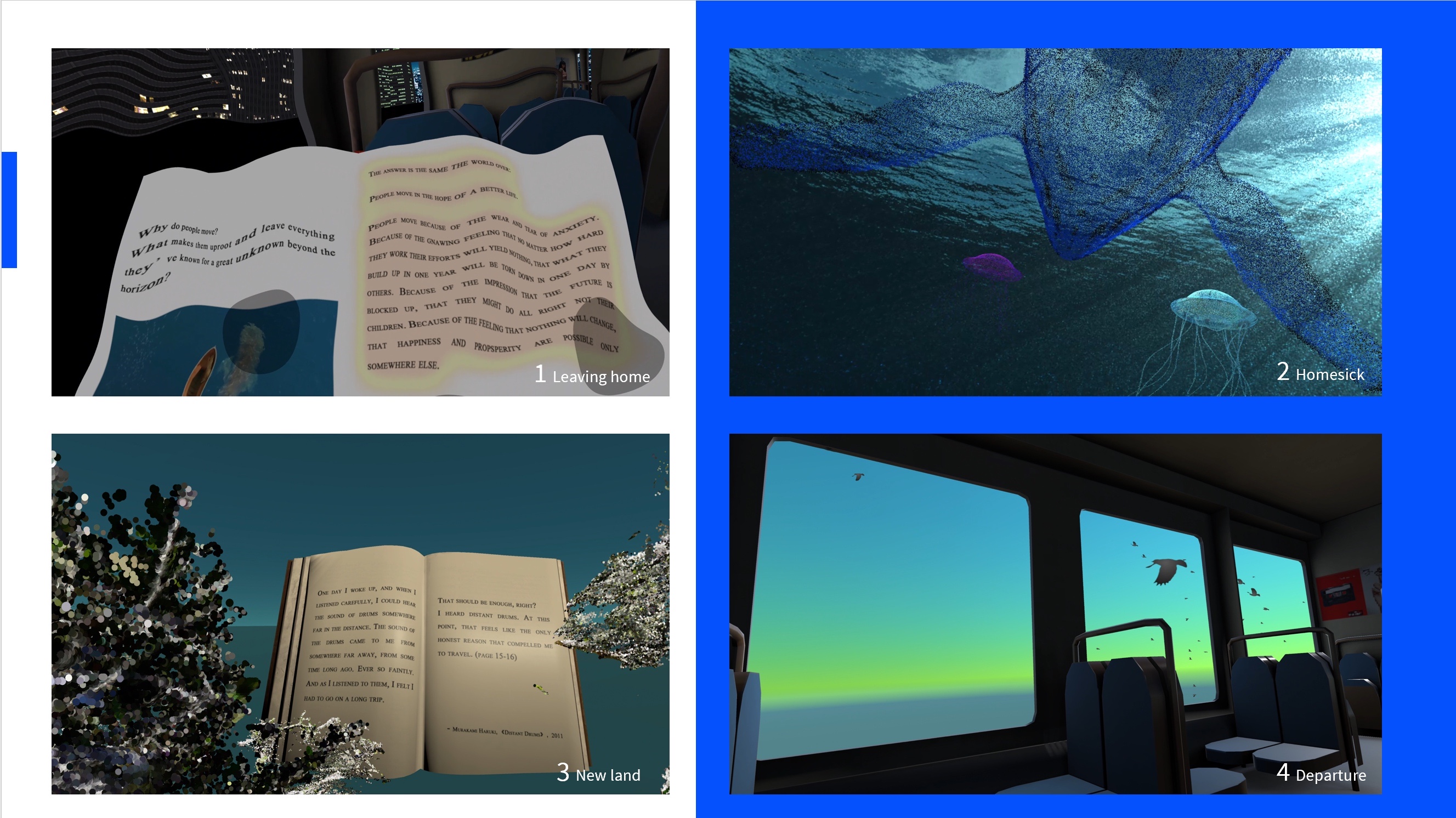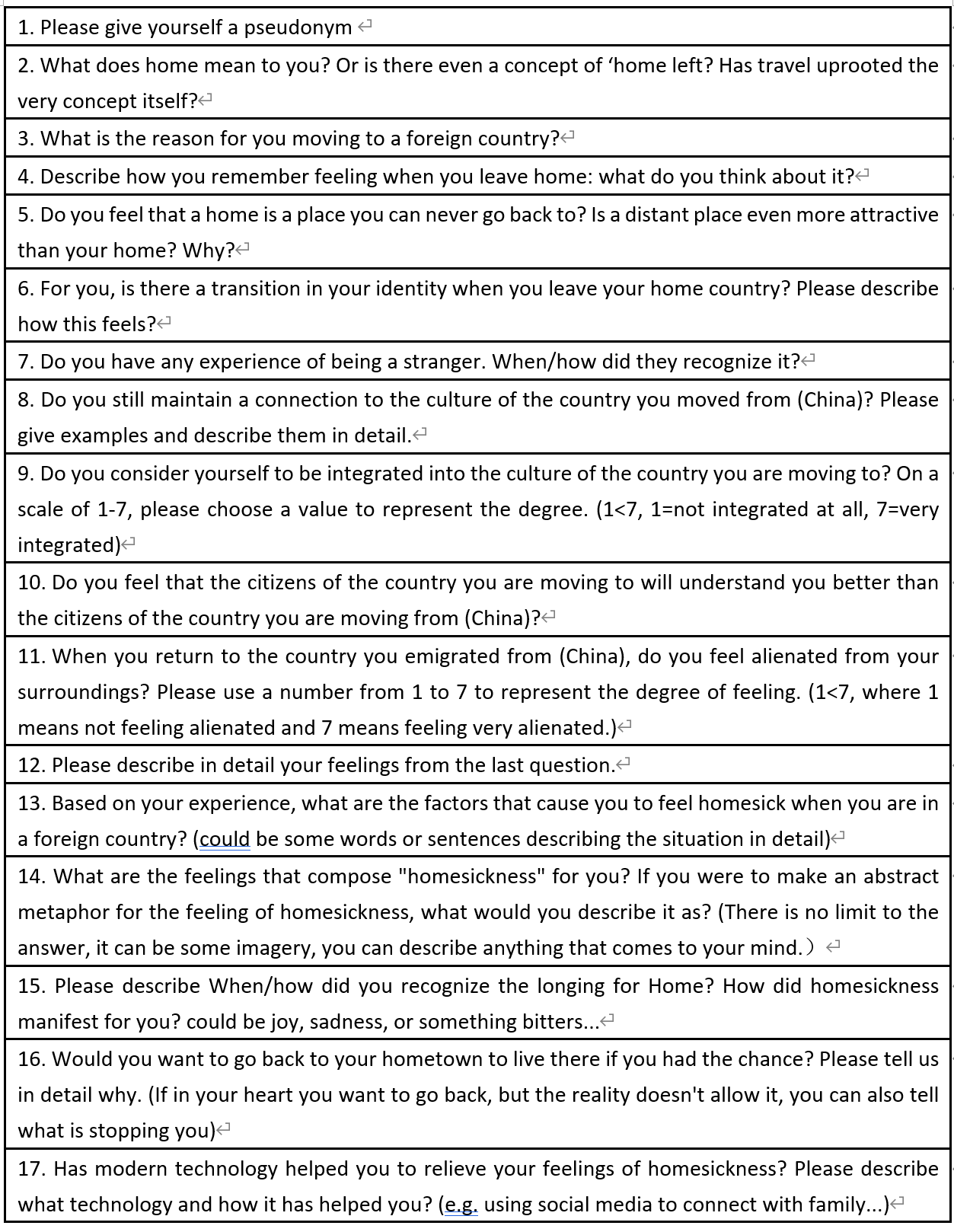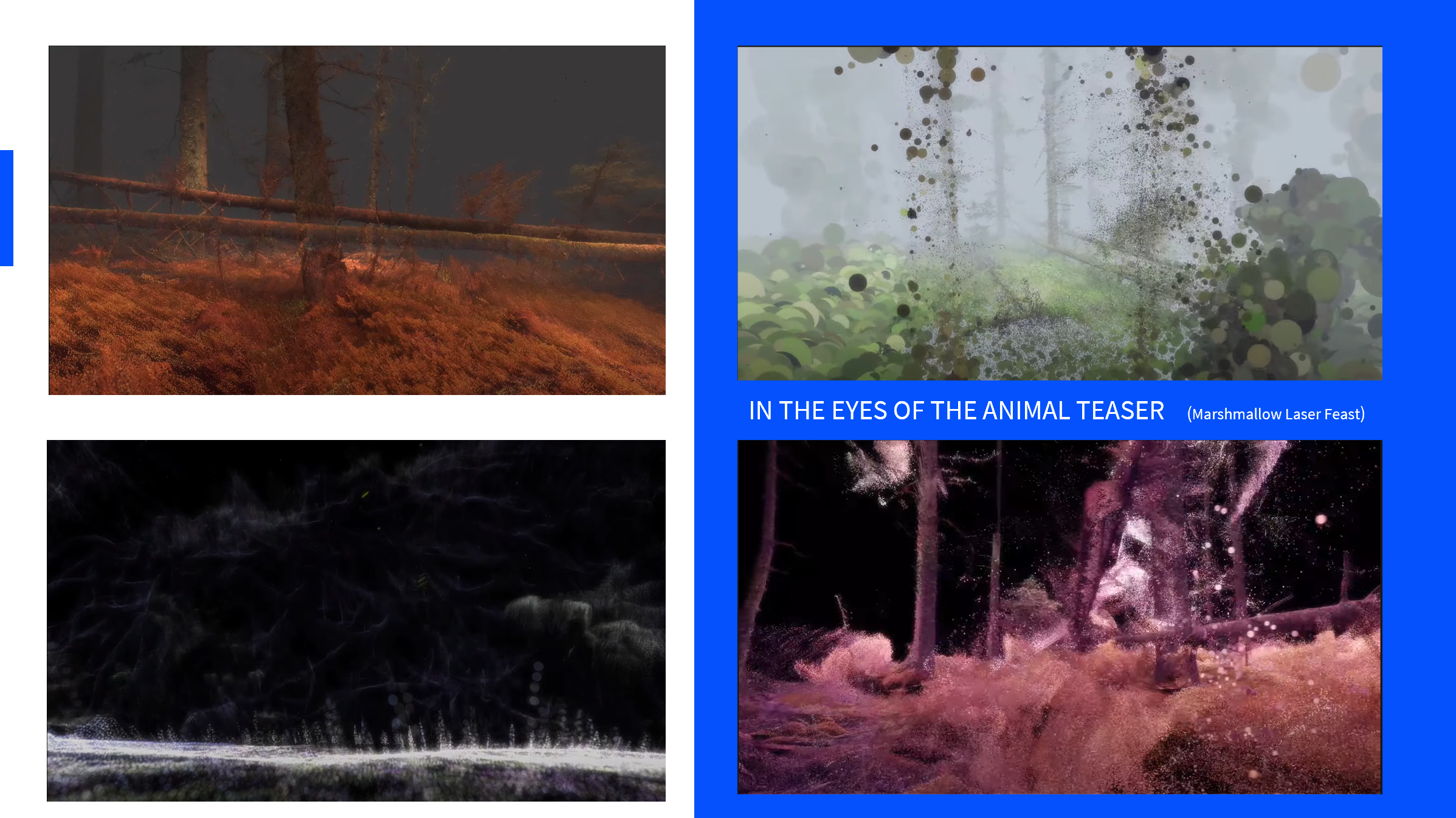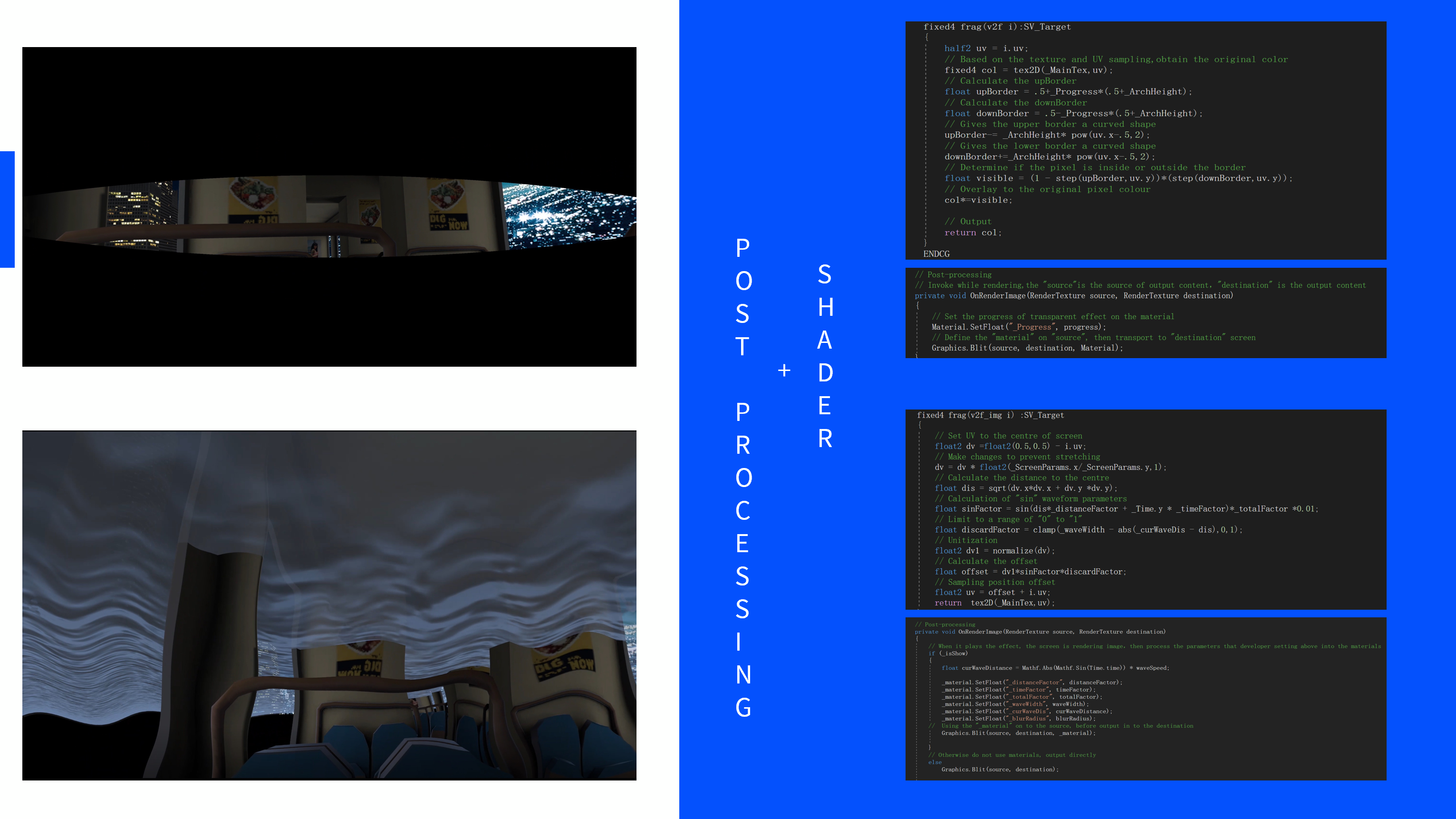Je Me Souviens
This VR project aims to show a personal stream-of-consciousness about the feeling of homesickness on a journey of the train, to represent the changing state of mind when a traveler starting a journey.
produced by: Chaojing Li
Introduction
My homeland cannot follow my will, and a foreign land cannot remove my sleepiness.
(故土沒法跟隨我意願, 異國沒法消除我睏倦。)
- My little airport (2007)
Why do people leave their homeland?
I experience both Heimweh (homesickness) and Fernweh (the longing for distant places). On countless times of 'leaving home' and 'back home', hometown has become a distant dream. I know I will never return to my hometown, but I still feel sad every time I leave.
The human brain is like a computer, with each person’s brain containing a unique code and all the experiences and emotions hidden in the subconscious functioning like algorithms that perform calculations, eventually giving rise to images derived from a stream of consciousness. In philosophy and psychology, there is a concept named “Qualia”, which define as individual instances of subjective conscious experience. We all have a different kind of qualia, which is a feeling that is difficult to convey in full with words, text, pictures, or any single medium. But with VR, it is a great medium to help creators tell that feeling based on their own experiences, to describe such feeling unspeakably.
You will be on a train heading to a distant land. As you watch the familiar streets move away from you, you hear the familiar sound of the clock chiming. The tide of longing rises to your heart, gradually pulling you to the depth ocean...
Concept and background research
The motivation for this VR project originated from the image that comes to my mind whenever I leave home and set foot for the far away. On countless occasions, whenever leaving home my mind has been beset by the imagination of pervading seawater gradually rising from under my feet, submerging my whole body, and rendering me unable to breathe. I am like a diver, sinking deep into the sea. Such a stream of consciousness experience is my personal feeling of homesickness.
Deconstructing my imagination, I understand that on the surface I seem to feel suffocated because of homesickness, but in truth, it is the contrary. The sea represents the strangeness of new things. People who have experienced diving know that when first submerging into the sea, one has a strange fear. However, once used to it, the underwater world is exhilarating. To equate the feeling of leaving home with sinking into the sea represents not sorrow, but courage - to summon one’s heart and soul to explore a new world.
Every creator is bestowed with a creative theme that must be completed in his or her lifetime. What I desire is to explore the tangled emotional state of “leaving home, missing home, but never returning again”. I have met many people during my journey who have experienced the same migration as me and their experiences always hold a particular attraction for me. Therefore, I decided to take the opportunity of the graduation exhibition to express this feeling.
There are two words from Germany: Heimweh (homesickness) and Fernweh (the longing for distant places), perfectly express complex emotions around the topic of homesickness. According to the National Museum of Norway, “Heimweh” and “Fernweh” are not in fact two opposed emotions but two sides of the same problem. Their main common denominator is the notion of longing to find oneself. It is the quest to know ourselves in the world that drives us out to foreign countries and back home again. They seem to agree on one thing: it is no longer possible for us to return home and stay.
Concept design

Figure 1 Screenshot of four scenes
I designed this project on four scenes, every scene has the main theme: Leaving home(1), Homesick(2), New land(3), Departure(4), which represents different states of mind of the protagonist. In the first scene, the protagonist is reading the book “Life of Pi” by Yann Martel(2001). It is a book talking about the immigration process of an Indian family. I highlighted one paragraph in this book, which I hope to convey sideways the reason why the protagonist left her home. At this time, she hears the chiming song on the train which is like the sound of the clock at her Grandma's, this sound recalls the protagonist's innermost feelings of homesickness. Her tears spill out and drip onto the pages of the book. At this moment, the protagonist will see the seawater rising up to her feet, then completely submerging her. Here I wish to create a feeling of suffocation, where the sea symbolizes "the fear of the unfamiliar" and "the reluctance to be separate from home ".

Figure 2 Design draft of Scene1
Scene 2 and scene 3 show the world of the protagonist's consciousness, so I chose to use point clouds for these two scenes to distinguish them from scenes 1 and 4, which represent the real world. In scene 2, the surrounding will become different from those on the train, I used some spooky sound effects to create a disorienting state of mind. In this fictional ocean, the protagonist meets migrating whales and jellyfish, these are visions in her consciousness.
In scene 3, crossing the train carriage surrounded by some warm light spots, the protagonist arrives in a new land composed of point clouds. Here I have chosen a piece of music that makes people feel hopeful. She began to explore this place. In the end, she finds a book with words from Haruki Murakami. This book says since the author heard the sound of drums from far away (it is a metaphor: to represent the vision of a faraway land), then make the decision to start the journey. This is actually the true voice of the protagonist's heart, it appears in the form of a book in her unconscious world.
When the protagonist realizes this, she wakes up. Her mood brightened as the window turned into daylight (Scene 4).
Symbols
The train is an important symbol in this project, as Lynley stated: “The train journey shows that the main character is ‘moving on ', but emotionally.” In the scene1, the player is sitting on a train going to a faraway place. At this point, the character is facing in the direction of the departure, the implication here being that although she is traveling to a distant land, her heart has homesick at home. But in the last scene, when the player opens her eyes, her direction changed to the direction the train is going, and here I hint at a change of her state of mind. Many people have the experience of sitting on a train and looking out of the window in a meditative state, which is why I think this project will maybe resonate with the audience. In short, the train serves as a visual symbol of the intersection of reality, giving the audience a hint that the protagonist is in the feeling of homesickness and beginning of a subconscious journey.
Research study
I conducted two qualitative research about “the feeling of homesickness”. In the first study, I collected qualitative data by using metaphor form referring to S. Sezer, et al. (2021). I invited 50 ethnic Chinese people who had the overseas experience to describe their homesickness by filling the following sentence: “Homesickness is like a/an ……… Because ……...” In the metaphor technique. Finally, I collected all the qualitative data and using the Write Words to count the word frequency, then using the Word It Out to generate the word cloud (Figure 1). In this part of the study, I attempted to find out Chinese people’s common sense of homesickness.

Figure 3 Word cloud of Chinese people’s common sense of homesickness
In the second study, I conducted the qualitative questionnaire under the theory model of acculturation, to compare the differences and similarities about the “concept of home, sense of being stranger, feeling of homesickness” between three peoples of Traveler, Migrant, and Diaspora. The following table (Table 1) contains the questions I asked the three participants. As a result, although the three participants showed varying degrees of 'homesickness' for their country of emigration due to their different identities and experiences, I found that all three participants showed a new age 'digital diaspora' characteristics.

Table 1 Qualitative research about "Homesickness" between three Chinese peoples of "Traveler, Migrant, and Diaspora"
Related work
In the earlier stage, I was fascinated by Marshmallow Laser Feast's work IN THE EYES OF THE ANIMAL TEASER, and I dreamed of making something similar to the visuals in their work. After exploring the process of making my project, I think I have understood the basic methodology they used to make such a piece.

Figure 4 Inspired from the art work of Marshmallow Laser Feast
Technical application
I used Virtual Reality headset HTC VIVE PRO EYE to develop this project in Unity 3d game engine and using Oculus Quest with link to perform it on the exhibition. For the computational part, I create point cloud models, water simulation, custom shader, manage the game asset (audio, model, effect), and coding for different VR controllers. In the meantime, I used the technology of eye-tracking to allow the audience to steer the direction with eye movement in the environment. However, since I attend the exhibition remotely, I can’t rent a VR headset with eye-tracking in the UK, so I changed the navigation method to simply using a VR controller to move.
Point cloud
I was curious about how to create the point cloud in the unity3d game engine, and I found three pathways to archive it. (1) I am thinking to draw the point cloud in the Unity, I found a workable way to do that: Saving the PointCloud file in .csv format, and reading the coordinate position of each point. After that, using a particle system to draw the point, and coding for the particle system to control the movement of each point. But for this method, there is a problem that, the file .csv cannot store the RGB information, thus all the points will have the same color, which will be reduced the aesthetic quality. (2) Using Polycam LiDAR 3D scanner app to scan and create 3D models. (3) Using FM points plugin from unity asset store which allows the creator to translate 3D models to .ply format with the RGB information.

Figure 5 Experiments of using PolyCam LiDAR 3D scanner to create models and cloud point
Water simulation
It involves creating two water surfaces in this project. One is in the first scene which symbolizes the sad emotion of the protagonist, another one is in scene 2, which is a particle ocean representing the world of consciousness. Based on Catlike’s tutorial, I learn that there are two methods to calculate the water wave. The simple one is a sin wave, which does not match the shape of real water waves, another one is Gernster waves, which is often used for real-time animation of water surfaces, it is more approach the nature.
I learn from the research of Rafal Wilinski, using the Perlin noise algorithm to produce a particle ocean. Based on this, I public the new space range, scale range, and height range to generate a more undulating ocean.

Figure 6 Experiments of wave simulation
Attempting to write Shader and Post-processing for visual effect
I have learned and create custom shaders to make two visual effects: 1. To simulate the effect of the player waking with the blink. 2. To simulate the effect of the teary-eyed world seen when the protagonist cries. Then I used [OnRenderImage] Unity Scripting API for writing post-processing to render the result into the camera by using [Graphics. Blit].

Figure 7 Shder+Post-processing
Future development
I have a constant stream of inspiration for this work. I need to continue to fill this piece with content to make it more sophisticated.
For example, when the protagonist sinks into the deep sea, using shifting particles to generate some symbols that represent hometown. When the player blows into the VR headset microphone, they can disperse these things, which represent an emotional restraint of people’s homesickness. I may archive it by using Hologram rays and Particle Morphing in the VFX system of Unity.
Besides that, keep learning post-processing and custom shader can help me to stylized this project. In addition, I can use the animations creation tool Quill to build more 3D models in the future.
Self-evaluation
Firstly, cheers for the smooth completion of my remote participation in the exhibition! I bought a used, but mostly new laptop from Amazon to participate in the exhibition. I strongly appreciate my classmate Hankun Yu, without whom I would not have been able to remotely install my project at the graduation show.
Reflections
I spent a fair time on the preliminary research and story design, as well as the technical experiment. I started to make official production late, which made me a bit rushed. Even so, I still feel that the preliminary research and technical exploration brought me a lot of rewards. The greater significance of this project for me is that I learned more about myself during the research process. In the future, I may try to use other media to express the same emotion.
Something negative
- I didn't tell a specific 'story', but I think that's what I wanted to do. I achieved the core of my original concept - using some metaphors to imply what I intend to express. Perhaps the audience doesn't get a clear sense of the emotion I'm trying to convey from the work without explanation - is that a bad thing? I am not sure, but for me, I prefer the audience to feel what I'm making than for them to know directly what I'm making.
- My ambition was to render this project with a URP pipeline and using VFX to create a more spectacular effect. In the end, it didn't archive. My consideration was this ambition requires a better GPU, I was worried that the laptop I bought (or rent) from Amazon would not support it to run smoothly. To complete the exhibition more safely, I chose to use a build-in pipeline to complete this project.
- As I was attending the exhibition remotely, I finally borrowed Hankun's Oculus Quest to run my work. Although I made some changes to the code, I still receive feedback that Scene 3 was very stuck. When I run this project on HTC VIVE PRO EYE, Scene3 works smoothly. This may be because there is still an incompatibility issue between Oculus Quest and SteamVR Unity Plugin.
Something positive
- Based on my vision of the point cloud effect, I have learned and explored the process of creating point clouds. I now have the basic methodology to achieve this effect, it will greatly help me to produce more kinds of this artwork in the future.
- I start to learn coding custom shaders and post-processing.
- In the course of doing research, I get to know myself better and to reflect on the experiences of others. And I archived to express emotions in a personal and experiential way.
- Finally, I get my answer at the end of this research journey: “Heimweh (homesickness)” is to find the sense of belonging, and Fernweh (the longing for distant places), is for discovering oneself with new possibilities. Like the National Museum of Norway states: ”Identity is a journey that is unfinished.”
References
Artwork
https://www.e-flux.com/announcements/34416/unfinished-journeys/
https://www.youtube.com/watch?v=XJMA0Nj_zsA
Lee, A. (2012). Life of Pi. Fox 2000 Pictures.
Research
Tianwen, Dai. (2019, May 24). [Depth] Jia Zhangke: Leave your hometown to gain it. Jiemian.com. https://www.jiemian.com/article/3153781.html
Martel, Y., 2013. Life of Pi. Toronto: Alfred A. Knopf Canada.
Jung, C., R.F.G.Hull. (1970). Four Archetypes - Mother rebirth spirit trickster. Princeton University Press. https://www.sas.upenn.edu/~cavitch/pdf-library/Jung_MotherArchetype.pdf
SLAP HAPPY LARRY. 2019. The Symbolism of Trains In Literature. [online] Available at: https://www.slaphappylarry.com/trains-symbolism-literature/
Şenol, S., Nermin, K., Muhammet, N. (2021) A multidimensional analysis of homesickness based on the perceptions of international students in Turkey: A mixed-method study, International Journal of Intercultural Relations, Volume 83, Pages 187-199, ISSN 0147-1767. https://doi.org/10.1016/j.ijintrel.2021.06.001.
Haruki, M. (1990). Distant Drums(遠い太鼓). 講談社文庫.
Code / Tutorial / Manual
https://docs.unity3d.com/Manual/upm-scoped.html
https://docs.unity3d.com/2018.1/Documentation/Manual/PostProcessingWritingEffects.html
https://rafalwilinski.medium.com/tutorial-particle-sea-in-unity3d-70ff1350fa9e#.a2obqtys6
https://github.com/keijiro/Pcx
https://catlikecoding.com/unity/tutorials/
Asset used (models/audio/music)
https://www.bensound.com/royalty-free-music/track/katia-s-garden-delicate-piano-soft (HOLDING A LICENSE CERTIFICATE)
https://freesound.org/people/triadtravelogues/sounds/467904/
https://freesound.org/people/RTB45/sounds/151807/
https://freesound.org/people/AudioWay/sounds/493905/
https://freesound.org/people/Robinhood76/sounds/95801/
https://freesound.org/people/Setuniman/sounds/403968/
https://freesound.org/people/InspectorJ/sounds/339326/
https://assetstore.unity.com/packages/3d/props/exterior/city-pack-42685
https://sketchfab.com/3d-models/tramway-120b03a1ba864f7bb5c66cf240be1b64
https://sketchfab.com/3d-models/subway-train-car-point-cloud-version-cc1d9f99f3584fa1a662c3c2154e9fd4






























































